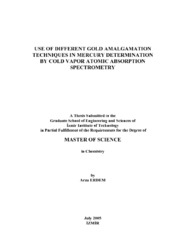Please use this identifier to cite or link to this item:
https://hdl.handle.net/11147/3259Full metadata record
| DC Field | Value | Language |
|---|---|---|
| dc.contributor.advisor | Eroğlu, Ahmet Emin | - |
| dc.contributor.author | Erdem, Arzu | - |
| dc.date.accessioned | 2014-07-22T13:51:12Z | - |
| dc.date.available | 2014-07-22T13:51:12Z | - |
| dc.date.issued | 2005 | - |
| dc.identifier.uri | http://hdl.handle.net/11147/3259 | - |
| dc.description | Thesis (Master)--İzmir Institute of Technology, Chemistry, İzmir, 2005 | en_US |
| dc.description | Includes bibliographical references (leaves: 48-51) | en_US |
| dc.description | Text in English; Abstract: Turkish and English | en_US |
| dc.description | xi, 51 leaves | en_US |
| dc.description.abstract | A novel amalgamation/cold vapor atomic absorption spectrometric system was developed for the determination of Hg(II) concentration in water samples. In the next part, an amalgamation unit utilizing various Au-coated sorbents was constructed and tested in the determination of mercury. Among the new amalgamation materials suggested, gold-coated quartz wool was found to be the most efficient although gold sputter-coated carbon fiber gave also very promising results. Analytical performance of the CVAAS system in terms of sample volume, limit of detection, and without/with amalgamation was also investigated. It was observed that the mercury signal increased with increasing sample volume, as expected. On the other hand, provided that the absolute amount of Hg(II) was kept constant while changing the sample volume, use of amalgamation unit resulted in similar calibration sensitivities. With amalgamation, the linearity and the slope of the calibration plots were not dependant on the sample volume and this property is expected to offer an important advantage since it makes the volume adjustment unnecessary. The limit of detection was also improved with amalgamation. The highest improvement was obtained with 2.0 ml sample volume; the limit of detection was 3.5 times lower (3.5 times better) than that of without amalgamation when 5-times trapping was employed. The results demonstrated that the methodology can be applied to these types of samples directly or after amalgamation, depending on Hg(II) concentration. | en_US |
| dc.language.iso | en | en_US |
| dc.publisher | Izmir Institute of Technology | en_US |
| dc.rights | info:eu-repo/semantics/openAccess | en_US |
| dc.subject.lcc | QD181.H6 .E66 2005 | en |
| dc.subject.lcsh | Mercury | en |
| dc.subject.lcsh | Amalgamation | en |
| dc.subject.lcsh | Atomic absorption spectroscopy | en |
| dc.title | Use of Different Gold Amalgamation Techniques in Mercury Determination by Cold Vapor Atomic Absorption Spectrometry | en_US |
| dc.type | Master Thesis | en_US |
| dc.institutionauthor | Erdem, Arzu | - |
| dc.department | Thesis (Master)--İzmir Institute of Technology, Chemistry | en_US |
| dc.relation.publicationcategory | Tez | en_US |
| dc.identifier.wosquality | N/A | - |
| dc.identifier.scopusquality | N/A | - |
| item.openairecristype | http://purl.org/coar/resource_type/c_18cf | - |
| item.languageiso639-1 | en | - |
| item.openairetype | Master Thesis | - |
| item.grantfulltext | open | - |
| item.fulltext | With Fulltext | - |
| item.cerifentitytype | Publications | - |
| Appears in Collections: | Master Degree / Yüksek Lisans Tezleri | |
Files in This Item:
| File | Description | Size | Format | |
|---|---|---|---|---|
| T000354.pdf | MasterThesis | 3.09 MB | Adobe PDF |  View/Open |
CORE Recommender
Page view(s)
224
checked on Mar 31, 2025
Download(s)
96
checked on Mar 31, 2025
Google ScholarTM
Check
Items in GCRIS Repository are protected by copyright, with all rights reserved, unless otherwise indicated.